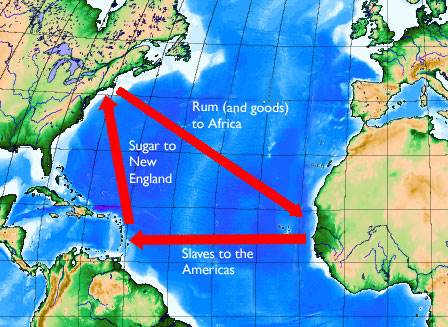Triangular Trade and Piracy
The rise of piracy after turbulent events such as wars were always connected to the shipping routes and large government trade fleets. While the Asian pirates were focused on mostly disturbing the shipping lanes between China and India, the Atlantic pirates in the Golden Age of Piracy were praying on the complicated shipping lane network that was called “Triangular Trade”. This term represents the tendency of merchant ships to travel not between two ports, but to maximize their profits by sailing to three continents. This kind of trade evolved not only out of needs and offerings of particular markets, providing finished goods to undeveloped regions and shipping raw materials back from newly discovered lands back to Europe, but also because of the trade winds that were present on Atlantic. Those winds promoted repeated use of certain naval routes that were used during entire age of Sail.
During the height of 17th and 18th-century piracy, one arm of the several types of triangular trade was always connected with the transport of slaves from Africa to the Americas (Central American islands and North America). Best known example of triangular trade involved sailing of ships filled with manufactured goods from Europe to the equatorial Africa, where they collected African slaves and traveled westward below 30 N latitude using regular “trade winds” that carried them all over the Caribbean islands (due to poor conditions on those trips, significant portion of African slaves died before ever reaching the Caribbean). After selling their slaves in Caribbean, Gulf of Mexico or southern North America (almost always to cotton or sugar farmers), they filled their ships with raw goods collected in the New World (cotton, tobacco and sugar in the liquid molasses form) and traveled eastward toward Europe following the northern part of Gulf Stream where westerly winds blow.
However, even though this form of trade was profitable and offered many good trade opportunities, merchants who got involved in Atlantic triangle trade route that involved slaves were often faced with many difficulties. There were very little ships that could easily accommodate both the transportation of goods and slaves. Poor living conditions of slaves created health issues for all onboard those ships and issues with their purchase in Africa often required ships to miss their travel deadline and to arrive in the Americas out-of-season, forcing them to wait for crops to become ready for transport or to fill up their ships with insufficient cargo and stabilize the ship with inert ballast. The average travel time for Atlantic was one year, which reduced the possibility for quicker trades. Of course, Caribbean pirates were also a big threat.
While this traditional form of triangular trade in Atlantic was used by many merchant ships, there were other types of trade. One of the favorite ones was the one that replaced ports in Europe for the ports in New England, specifically the state of Rhodes Island. During American Revolutionary War, triangular trade was established between Great Britain, Caribbean, and British North America. In the 1820s and 1830s “sugar triangle” was established between North America, Cuba and the European Baltic coast. Newfoundland was also a point in a triangular trade during good trade relations with Boston ports and Europe.


